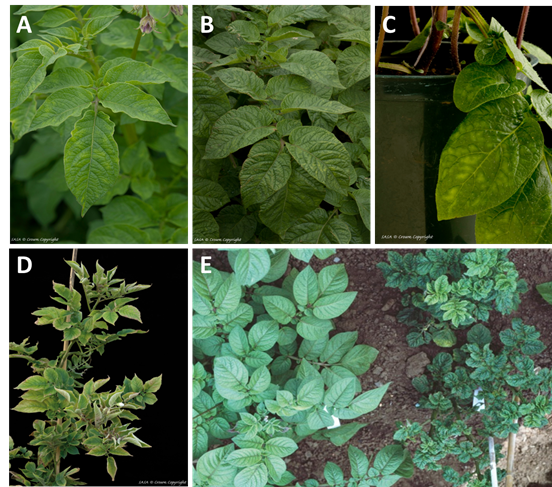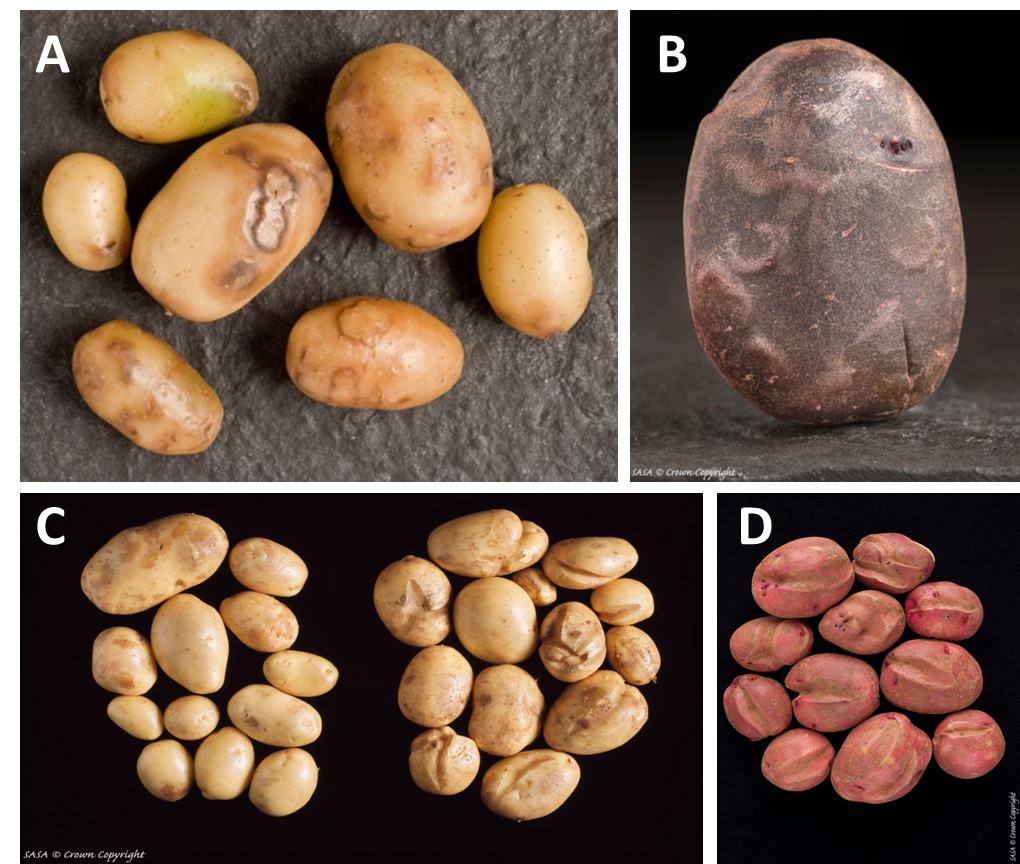Please click here to access the main AHDB website and other sectors.
- Home
- Knowledge library
- Potato viruses: symptoms
Potato viruses: symptoms
The main virus species in GB potato crops is currently Potato Virus Y (PVY)
There are different strains and variants of PVY (e.g., PVYO, PVYC, PVYN, PVYNTN). These reflect differences that can be detected primarily according to their biology (e.g., the symptoms they cause), antibody-based detection methods like ELISA and using molecular techniques. More than one method is often needed to identify the viruses.
It is generally accepted that isolates of the PVYN strain group cause milder mosaic symptoms on most potato cultivars than isolates of the PVYO strain group.
Symptoms
Primary infection occurs in the growing season and is aphid-borne. Secondary infection is tuber-borne.
Symptoms of primary infection can sometimes be seen but this probably varies with the variety, environment/season and timing of infection. Diseased (symptomatic) plants are generally the result of secondary transmission from infected tubers.
Symptoms include chlorotic mosaics in the haulm with possible pallor, leaf deformation, reduced leaflet size and overall reduction in vigour. Susceptible varieties could also produce smaller tubers.
Mixed infections are when a plant is infected by different virus species and this generates more severe symptoms (i.e. severe mosaic, stunting).
Symptoms Q&A
What sort of symptoms would I expect to see in (a) haulm and (b) tubers if my crop had PVY?
There will be a range of symptoms from almost asymptomatic through mild to severe chlorotic mosaics in the haulm with possible pallor, leaf deformation, reduced leaflet size and overall reduction in vigour. This will depend on the PVY strain and the potato variety.
Susceptible varieties could produce smaller tubers. The most obvious tuber symptom associated with potato viruses is Potato Tuber Necrotic Ring Disease associated with infection of susceptible varieties with PVTNTN type isolates. Work at SASA also correlated the presence of mosaic symptoms in haulms with the presence of tuber cracking. However, tuber cracking (also known as “elephant hide”) can also be caused by the fungus Rhizoctonia solani and other stresses that affect the development of the plant such as drought stress.
Do we see symptoms of primary infection in crops?
(Primary infection occurs in the growing season and is aphid-borne. Secondary infection is tuber-borne). Conventional wisdom says that the virus you see this year was spread last year, though in years with early transmission, it is possible that virus could be seen in the year of infection (i.e. primary infection) and there is some anecdotal evidence to support this.
Are any particular varieties more susceptible than others?
National List (NL) testing includes assessments of variety susceptibility to PVYO/C, PVYN, PVA and PLRV. Infected tubers are used to introduce virus inoculum into the trial plots that are planted with virus-free tubers of test varieties as well as known resistant and susceptible control varieties. The amount of virus infection in the tubers of the test plants is assessed at the end of the growing season, using a growing-on test. The incidence of infected tubers in relation to the susceptible and resistant control varieties is used to determine a resistance rating (scale of 1 – 9; with 9 = high resistance). This doesn’t provide information on symptom expression.
In Scotland, SASA report information on variety propensity. The term has been adopted to describe whether symptoms observed within a variety are above or below the average across the whole Scottish seed crop (i.e. Propensity = % of diseased crops of variety /% of diseased crops of all varieties).
The propensity values are calculated from the results of laboratory virus diagnoses on leaf samples submitted to SASA from plants exhibiting virus symptoms during crop inspections (PVYN, PVYO/C, PVA and PVV). Values greater than 1 indicate that a virus/symptom is more likely to be found in that variety and values less than 1 indicate that it is less likely to be found in that variety. As the reliability of propensity data depends upon the inspection and sampling of an extensive number of crops, it is less reliable for varieties with relatively few crops which are only grown over a relatively small area e.g., new varieties. However, propensity can be collected over many years and maybe statistically more robust than the virus tests that are carried out as part of the NL programme. It is also up to date in relation to assessments against the virus strains present in the field in recent years. Information is not available for England and Wales as laboratory tests are not carried out on symptomatic plants seen during seed crop inspections there.
Do some varieties have high levels of virus but no symptoms in leaves/ no effect on yield /tuber quality?
There is probably a complex interaction between the virus strain(s), potato variety and timing of infection on virus symptom expression. Importantly, the level of resistance or susceptibility to PVY of a variety and its ability to display symptoms of infection will impact on the virus distribution in the whole plant, its capacity to affect the development of the plant tuber formation and, ultimately, yield. Some varieties do not display symptoms of infection and their yields might not be affected. However, these varieties represent a source of virus inoculum that can be transmitted to, and affect, neighbouring susceptible varieties.

Potato plants displaying mild mosaic symptoms (A, B, C), leaf roll symptoms (D), severe mosaic and stunting (E).


